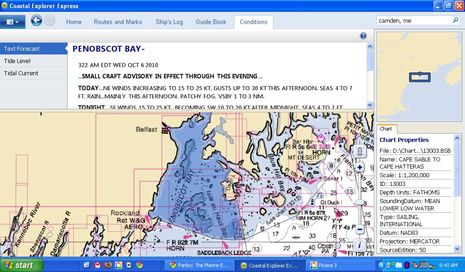Coastal Explorer Express & 2011; hello subscription model

Rose Point Navigation showed off numerous new products and features during the NMEA Conference, as mentioned on Tuesday, but it make take a while for me, or anyone, to sort them all out. This is especially true as the company has both a "relaxed" marketing style and a tendency to put product perfection over actual shipping dates. For instance, a week after issuing a stack of press releases, there's not yet a peep about them on Rose Point's home page, but instead a link to a "sneak peak" (sic) at Coastal Explorer 2010, a product that will never actually be released! What is new on the site is info about the heavily stripped down new version of CE called CE Express, which was announced last February in Miami but in fact is the first CE 2011-style software to ship. Except that the Google Earth-like chart zoom slider seen above in the copy of Express I downloaded last week has already been replaced in the ongoing CE 2010 beta...
But as bumbling as all that may sound, the actual experience of Coastal Explorer users has been terrific. All direct Rose Point customers were updated to CE 2009 for free (the exception being CNP owners), and then all were welcome to experience CE 2010 as a series of "beta" updates, which
seemed quite stable, at least to me, and interestingly different as Brad Christian and his team worked to remake the interface and add even more features without clutter. Meanwhile, more and more online services (known as the Coastal Explorer Network), like automated chart updates, blog space, photo maps, guides, and weather data, were served for free. In fact, I think the total package is now so strong that few users will howl when they learn that this free-updates-and-data-forever gravy train is about to come to a screeching
halt.
According to last week's release, as of 1/1/2011 access to what will be called Coastal Explorer 2011 along with all the goodies on the CE Network including ongoing updates that may or may not be called "betas" will cost current CE owners a $100 annual subscription fee. For people buying CE for the first time at $399, the first $100 subscription will be included, as is the $50 annual subscription for the $100 CE Express edition. The Express subscription is less because use of many online services has been stripped out along with vector chart support, Cruise Mode, and much else. Rose Point has put up a detailed feature grid of the differences between the full version, Express, and also the free chart viewer/planner now available. And I'm sure they'll put up the various press releases sooner or later {done!}, and we can soon discuss some of the other very interesting things they're up to, like automatic downloaded and live data sharing between, say, a laptop which runs CE 2011 when online at home and an onboard PC running CE and attached to the suite of hardware products Rose Point is also introducing.
Below, by the way, is the new, new screen controls as seen in the latest CE 2010 beta and which will probably be in CE 2011 and maybe Express too once the code base is aligned. I was getting used to the zoom bar and buttons on the upper right hand side of the screen, but I get how this version -- in which the slider and scale notations box only appears when your mouse hovers over the zoom buttons -- is even better. The more unobstructed chart, the better. And if Brad wants to change the buttons again, so be it; I've developed a lot of trust in his evolving vision of how charting software should work. Now, if Rose Point would just get a wee bit better at telling us what's going on and meeting the deadlines they do reveal...

 Share
Share
I remember several years back a privately held navigation software company started charging enormous fees for their three or four times a year updates along with their proprietary charts and fees for chart updates. Once they had their customers onboard the company was quickly sold and the owners left with lots of money. The price of the software went up and the company was sold again. I wonder if this is the road Rose Point is headed down.
I honestly don't think many customers will pay $100 a year for the right to use full featured software they have been using now for years fee-less. I'm personally not interested in a stripped down version of what I'm used to either. Maybe it's time to start shopping for a "no fee" navigation software alternative. In a poor economy $100 a year eliminates all the cruisers, most sailors and half the power boaters. Lobstermen are totally out of the" fee for charting" customer base. I suppose though Rose Point did some serious market research into this plan so maybe I'm totally out to lunch on this.